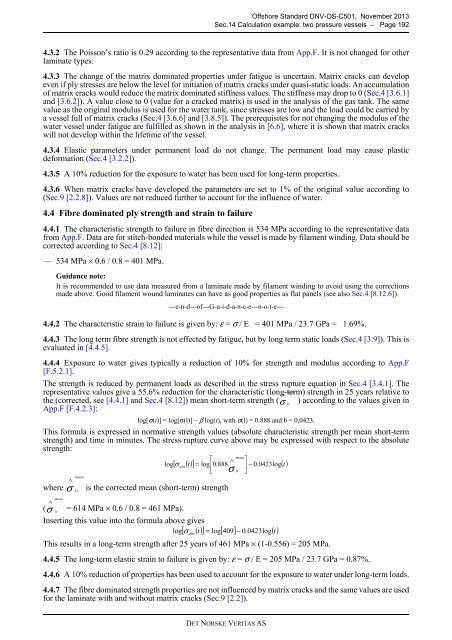OS-C501
You also want an ePaper? Increase the reach of your titles
YUMPU automatically turns print PDFs into web optimized ePapers that Google loves.
Offshore Standard DNV-<strong>OS</strong>-<strong>C501</strong>, November 2013<br />
Sec.14 Calculation example: two pressure vessels – Page 192<br />
4.3.2 The Poisson’s ratio is 0.29 according to the representative data from App.F. It is not changed for other<br />
laminate types.<br />
4.3.3 The change of the matrix dominated properties under fatigue is uncertain. Matrix cracks can develop<br />
even if ply stresses are below the level for initiation of matrix cracks under quasi-static loads. An accumulation<br />
of matrix cracks would reduce the matrix dominated stiffness values. The stiffness may drop to 0 (Sec.4 [3.6.1]<br />
and [3.6.2]). A value close to 0 (value for a cracked matrix) is used in the analysis of the gas tank. The same<br />
value as the original modulus is used for the water tank, since stresses are low and the load could be carried by<br />
a vessel full of matrix cracks (Sec.4 [3.6.6] and [3.8.5]). The prerequisites for not changing the modulus of the<br />
water vessel under fatigue are fulfilled as shown in the analysis in [6.6], where it is shown that matrix cracks<br />
will not develop within the lifetime of the vessel.<br />
4.3.4 Elastic parameters under permanent load do not change. The permanent load may cause plastic<br />
deformation (Sec.4 [3.2.2]).<br />
4.3.5 A 10% reduction for the exposure to water has been used for long-term properties.<br />
4.3.6 When matrix cracks have developed the parameters are set to 1% of the original value according to<br />
(Sec.9 [2.2.8]). Values are not reduced further to account for the influence of water.<br />
4.4 Fibre dominated ply strength and strain to failure<br />
4.4.1 The characteristic strength to failure in fibre direction is 534 MPa according to the representative data<br />
from App.F. Data are for stitch-bonded materials while the vessel is made by filament winding. Data should be<br />
corrected according to Sec.4 [8.12]:<br />
— 534 MPa × 0.6 / 0.8 = 401 MPa.<br />
Guidance note:<br />
It is recommended to use data measured from a laminate made by filament winding to avoid using the corrections<br />
made above. Good filament wound laminates can have as good properties as flat panels (see also Sec.4 [8.12.6]).<br />
---e-n-d---of---G-u-i-d-a-n-c-e---n-o-t-e---<br />
4.4.2 The characteristic strain to failure is given by: ε = σ / E = 401 MPa / 23.7 GPa = 1.69%.<br />
4.4.3 The long term fibre strength is not effected by fatigue, but by long term static loads (Sec.4 [3.9]). This is<br />
evaluated in [4.4.5].<br />
4.4.4 Exposure to water gives typically a reduction of 10% for strength and modulus according to App.F<br />
[F.5.2.1].<br />
The strength is reduced by permanent loads as described in the stress rupture equation in Sec.4 [3.4.1]. The<br />
representative values give a 55.6% reduction for the characteristic (long-term) mean<br />
∧ strength in 25 years relative to<br />
the (corrected, see [4.4.1] and Sec.4 [8.12]) mean short-term strength ( σ ) according to the values given in<br />
1t<br />
App.F [F.4.2.3]:<br />
log[σ(t)] = log[σ(l)] – β log(t), with σ(l) = 0.888 and b = 0,0423.<br />
This formula is expressed in normative strength values (absolute characteristic strength per mean short-term<br />
strength) and time in minutes. The stress rupture curve above may be expressed with respect to the absolute<br />
strength:<br />
where<br />
∧<br />
∧<br />
σ 1t<br />
mean<br />
is the corrected mean (short-term) strength<br />
( = 614 MPa × 0.6 / 0.8 = 461 MPa).<br />
σ 1t<br />
mean<br />
[ σ ( t)<br />
] = log 0.888 − 0.0423log( t)<br />
Inserting this value into the formula above gives<br />
log[ σ ( t)<br />
] = log[ 409] − 0.0423log( t)<br />
log<br />
abs<br />
This results in a long-term strength after 25 years of 461 MPa × (1-0.556) = 205 MPa.<br />
abs<br />
4.4.5 The long-term elastic strain to failure is given by: ε = σ / E = 205 MPa / 23.7 GPa = 0.87%.<br />
⎡<br />
⎢<br />
⎣<br />
4.4.6 A 10% reduction of properties has been used to account for the exposure to water under long-term loads.<br />
4.4.7 The fibre dominated strength properties are not influenced by matrix cracks and the same values are used<br />
for the laminate with and without matrix cracks (Sec.9 [2.2]).<br />
∧<br />
σ<br />
mean<br />
1t<br />
⎤<br />
⎥<br />
⎦<br />
DET NORSKE VERITAS AS



